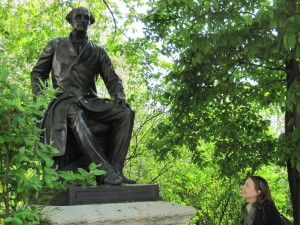 I was awarded an MA in Victorian Studies from the University of Exeter in 2005 and later returned to the Centre for Victorian Studies at Exeter to complete a PhD. While carrying out my doctoral research, I taught nineteenth-century literature to undergraduates, designed masterclasses for the University’s widening participation programme and presented at Victorian-themed academic conferences throughout the UK and the US.
I was awarded an MA in Victorian Studies from the University of Exeter in 2005 and later returned to the Centre for Victorian Studies at Exeter to complete a PhD. While carrying out my doctoral research, I taught nineteenth-century literature to undergraduates, designed masterclasses for the University’s widening participation programme and presented at Victorian-themed academic conferences throughout the UK and the US.
My PhD years were brilliant – challenging, stimulating and creative. They firmly established my interest in nineteenth-century history and they also shaped my work values: seeking out continuous opportunities to learn and connect with new people.
My PhD is a cultural history of the liberal philosopher John Stuart Mill (1806-1873). As one of the most well-known figures of the nineteenth-century, Mill was depicted extensively in journalism, caricatures, life-writing and fiction. Reading these diverse sources is often surprising. The received idea of Mill as the ‘Saint of Rationalism’ belies the extent to which he was associated with ideas of passion, sensitivity and tenderness. My guest post for the Cultural History of Philosophy blog explains how ideas about Mill’s ‘femininity’ were used to both attack and commend him, philosophically, politically and personally.
Victorian writers, artists and campaigners all recorded the effect of Millian philosophy on their work and on their emotional lives (I’ve written articles about how Thomas Hardy and Mona Caird drew on Mill and given public lectures at Dorset County Museum and Sir Harold Hillier Gardens).
Investigating these Victorian literary and journalistic encounters highlights the continued relevance of Mill to discussions of liberty, equality, diversity, individuality, self-development and education in the twenty-first century.